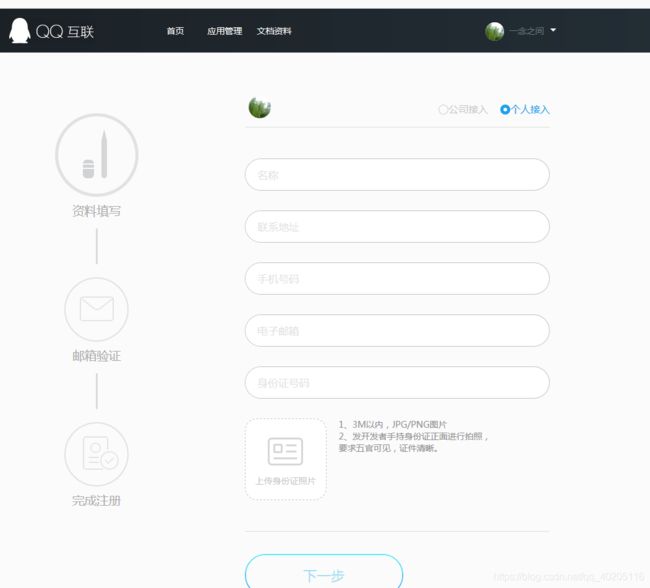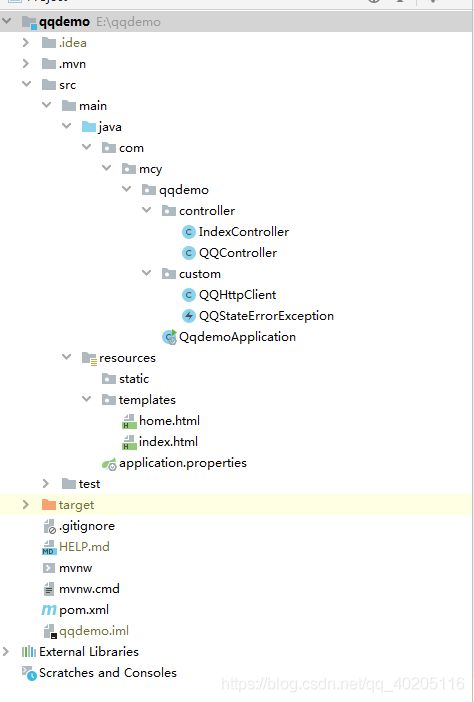Java实现QQ第三方登录
1.云服务器
2.备案的域名
3.本地调试需要修改hosts文件,将域名映射到127.0.0.1
如何修改hosts文件:https://www.cnblogs.com/toSeeMyDream/p/9313440.html
申请QQ互联,并成为开发者
申请QQ互联创建应用时需要备案域名,所以建议提前准备备案域名。
QQ互联:https://connect.qq.com/index.html
登录后,点击头像,进入认证页面,填写信息,等待审核。
审核通过后创建应用
应用创建通过审核后,就可以使用APP ID 和 APP Key
前期工作就这些了,后面可以开始写代码了。
项目结构:
properties或者yml配置文件(这里就是简单的配置了一下,可以自行添加数据库等配置)
-
server.port=
80
-
server.servlet.context-path=/
-
-
#qq互联
-
qq.oauth.http:QQ互联中申请填写的网站地址
在pom中添加依赖
-
-
<dependency>
-
<groupId>org.apache.httpcomponents
groupId>
-
<artifactId>httpclient
artifactId>
-
<version>4.5.6
version>
-
dependency>
-
-
<dependency>
-
<groupId>com.alibaba
groupId>
-
<artifactId>fastjson
artifactId>
-
<version>1.2.47
version>
-
dependency>
发送QQ登录请求
定义全局变量获取配置文件中的网站地址
-
@Value("${qq.oauth.http}")
-
private String http;
定义登录回调地址(可以用网站地址拼接或者直接写)
-
//QQ互联中的回调地址
-
String backUrl = http +
"/index";
登录请求方法代码
-
@GetMapping(
"/qq/login")
-
public String qq(HttpSession session) throws UnsupportedEncodingException {
-
//QQ互联中的回调地址
-
String backUrl = http +
"/index";
-
-
//用于第三方应用防止CSRF攻击
-
String uuid = UUID.randomUUID().toString().replaceAll(
"-",
"");
-
session.setAttribute(
"state",uuid);
-
-
//Step1:获取Authorization Code
-
String url =
"https://graph.qq.com/oauth2.0/authorize?response_type=code"+
-
"&client_id=" + QQHttpClient.APPID +
-
"&redirect_uri=" + URLEncoder.encode(backUrl,
"utf-8") +
-
"&state=" + uuid;
-
-
return
"redirect:" + url;
-
}
回调返回参数信息说明:
| 参数名称 | 描述 |
|---|---|
| ret | 返回码。详见公共返回码说明#OpenAPI V3.0 返回码。 |
| msg | 如果错误,返回错误信息。 |
| is_lost | 判断是否有数据丢失。如果应用不使用cache,不需要关心此参数。 0或者不返回:没有数据丢失,可以缓存。 |
| nickname | 昵称。 |
| gender | 性别。 |
| country | 国家(当pf=qzone、pengyou或qplus时返回)。 |
| province | 省(当pf=qzone、pengyou或qplus时返回)。 |
| city | 市(当pf=qzone、pengyou或qplus时返回)。 |
| figureurl | 头像URL。详见:前端页面规范#6. 关于用户头像的获取和尺寸说明。 |
| openid | 用户QQ号码转化得到的ID(当pf=qplus时返回)。 |
| qq_level | 用户QQ等级(当pf=qplus时返回)。 |
| qq_vip_level | 用户QQ会员等级(当pf=qplus时返回)。 |
| qplus_level | 用户Q+等级(当pf=qplus时返回)。 |
| is_yellow_vip | 是否为黄钻用户(0:不是; 1:是)。 (当pf=qzone、pengyou或qplus时返回) |
| is_yellow_year_vip | 是否为年费黄钻用户(0:不是; 1:是)。 (当pf=qzone、pengyou或qplus时返回) |
| yellow_vip_level | 黄钻等级,目前最高级别为黄钻8级(如果是黄钻用户才返回此参数)。 (当pf=qzone、pengyou或qplus时返回) |
| is_yellow_high_vip | 是否为豪华版黄钻用户(0:不是; 1:是)。 (当pf=qzone、pengyou或qplus时返回) |
| is_blue_vip | 是否为蓝钻用户(0:不是; 1:是)。 (当pf=qqgame或3366时返回) |
| is_blue_year_vip | 是否为年费蓝钻用户(0:不是; 1:是)。 (当pf=qqgame或3366时返回) |
| blue_vip_level | 蓝钻等级(如果是蓝钻用户才返回此参数)。 (当pf=qqgame或3366时返回) |
| 3366_level | 3366用户的大等级。 (当pf=3366时返回) |
| 3366_level_name | 3366用户的等级名,如小游游、小游仙。 (当pf=3366时返回) |
| 3366_grow_level | 3366用户的成长等级。 (当pf=3366时返回) |
| 3366_grow_value | 3366用户的成长值。 (当pf=3366时返回) |
| is_super_blue_vip | 是否是豪华蓝钻。 (当pf=qqgame或3366时返回) |
正确返回示例:
JSON示例:
-
Content-
type: text/html; charset=utf
-8
-
{
-
"ret":
0,
-
"is_lost":
0,
-
"nickname":
"Peter",
-
"gender":
"男",
-
"country":
"中国",
-
"province":
"广东",
-
"city":
"深圳",
-
"figureurl":
"http://imgcache.qq.com/qzone_v4/client/userinfo_icon/1236153759.gif",
-
"is_yellow_vip":
1,
-
"is_yellow_year_vip":
1,
-
"yellow_vip_level":
7,
-
"is_yellow_high_vip":
0
-
}
错误返回示例
-
Content-
type: text/html; charset=utf
-8
-
{
-
"ret":
1002,
-
"msg":
"请先登录"
-
}
用户资料的接口文档:https://wiki.open.qq.com/wiki/v3/user/get_info
请求成功,用户确认登录后回调方法
-
@GetMapping(
"/index")
-
public
String qqcallback(HttpServletRequest request, HttpServletResponse response) throws Exception {
-
HttpSession session = request.getSession();
-
//qq返回的信息
-
String code = request.getParameter(
"code");
-
String state = request.getParameter(
"state");
-
String uuid = (
String) session.getAttribute(
"state");
-
-
if(uuid !=
null){
-
if(!uuid.equals(state)){
-
throw
new QQStateErrorException(
"QQ,state错误");
-
}
-
}
-
-
-
//Step2:通过Authorization Code获取Access Token
-
String backUrl = http +
"/index";
-
String url =
"https://graph.qq.com/oauth2.0/token?grant_type=authorization_code"+
-
"&client_id=" + QQHttpClient.APPID +
-
"&client_secret=" + QQHttpClient.APPKEY +
-
"&code=" + code +
-
"&redirect_uri=" + backUrl;
-
-
String access_token = QQHttpClient.getAccessToken(url);
-
-
//Step3: 获取回调后的 openid 值
-
url =
"https://graph.qq.com/oauth2.0/me?access_token=" + access_token;
-
String openid = QQHttpClient.getOpenID(url);
-
-
//Step4:获取QQ用户信息
-
url =
"https://graph.qq.com/user/get_user_info?access_token=" + access_token +
-
"&oauth_consumer_key="+ QQHttpClient.APPID +
-
"&openid=" + openid;
-
-
//返回用户的信息
-
JSONObject jsonObject = QQHttpClient.getUserInfo(url);
-
-
//也可以放到Redis和mysql中,只取出了部分数据,根据自己需要取
-
session.setAttribute(
"openid",openid);
//openid,用来唯一标识qq用户
-
session.setAttribute(
"nickname",(
String)jsonObject.get(
"nickname"));
//QQ名
-
session.setAttribute(
"figureurl_qq_2",(
String)jsonObject.get(
"figureurl_qq_2"));
//大小为100*100像素的QQ头像URL
-
-
//响应重定向到home路径
-
return
"redirect:/home";
-
}
QQ客户端类QQHttpClient:
主要用于QQ消息返回
-
import com.alibaba.fastjson.JSONObject;
-
import org.apache.http.HttpEntity;
-
import org.apache.http.HttpResponse;
-
import org.apache.http.client.methods.HttpGet;
-
import org.apache.http.impl.client.CloseableHttpClient;
-
import org.apache.http.impl.client.HttpClients;
-
import org.apache.http.util.EntityUtils;
-
-
import java.io.IOException;
-
-
public
class QQHttpClient {
-
//QQ互联中提供的 appid 和 appkey
-
public
static
final String APPID =
"appid";
-
-
public
static
final String APPKEY =
"appkey";
-
-
-
private static JSONObject parseJSONP(String jsonp){
-
int startIndex = jsonp.indexOf(
"(");
-
int endIndex = jsonp.lastIndexOf(
")");
-
-
String json = jsonp.substring(startIndex +
1,endIndex);
-
-
return JSONObject.parseObject(json);
-
}
-
//qq返回信息:access_token=FE04************************CCE2&expires_in=7776000&refresh_token=88E4************************BE14
-
public static String getAccessToken(String url) throws IOException {
-
CloseableHttpClient client = HttpClients.createDefault();
-
String token =
null;
-
-
HttpGet httpGet =
new HttpGet(url);
-
HttpResponse response = client.execute(httpGet);
-
HttpEntity entity = response.getEntity();
-
-
if(entity !=
null){
-
String result = EntityUtils.toString(entity,
"UTF-8");
-
if(result.indexOf(
"access_token") >=
0){
-
String[] array = result.split(
"&");
-
for (String str : array){
-
if(str.indexOf(
"access_token") >=
0){
-
token = str.substring(str.indexOf(
"=") +
1);
-
break;
-
}
-
}
-
}
-
}
-
-
httpGet.releaseConnection();
-
return token;
-
}
-
//qq返回信息:callback( {"client_id":"YOUR_APPID","openid":"YOUR_OPENID"} ); 需要用到上面自己定义的解析方法parseJSONP
-
public static String getOpenID(String url) throws IOException {
-
JSONObject jsonObject =
null;
-
CloseableHttpClient client = HttpClients.createDefault();
-
-
HttpGet httpGet =
new HttpGet(url);
-
HttpResponse response = client.execute(httpGet);
-
HttpEntity entity = response.getEntity();
-
-
if(entity !=
null){
-
String result = EntityUtils.toString(entity,
"UTF-8");
-
jsonObject = parseJSONP(result);
-
}
-
-
httpGet.releaseConnection();
-
-
if(jsonObject !=
null){
-
return jsonObject.getString(
"openid");
-
}
else {
-
return
null;
-
}
-
}
-
-
//qq返回信息:{ "ret":0, "msg":"", "nickname":"YOUR_NICK_NAME", ... },为JSON格式,直接使用JSONObject对象解析
-
public static JSONObject getUserInfo(String url) throws IOException {
-
JSONObject jsonObject =
null;
-
CloseableHttpClient client = HttpClients.createDefault();
-
-
HttpGet httpGet =
new HttpGet(url);
-
HttpResponse response = client.execute(httpGet);
-
HttpEntity entity = response.getEntity();
-
-
-
if(entity !=
null){
-
String result = EntityUtils.toString(entity,
"UTF-8");
-
jsonObject = JSONObject.parseObject(result);
-
}
-
-
httpGet.releaseConnection();
-
-
return jsonObject;
-
}
-
}
异常类QQStateErrorException:
-
public
class QQStateErrorException extends Exception {
-
public QQStateErrorException() {
-
super();
-
}
-
-
public QQStateErrorException(String message) {
-
super(message);
-
}
-
-
public QQStateErrorException(String message, Throwable cause) {
-
super(message, cause);
-
}
-
-
public QQStateErrorException(Throwable cause) {
-
super(cause);
-
}
-
-
protected QQStateErrorException(String message, Throwable cause, boolean enableSuppression, boolean writableStackTrace) {
-
super(message, cause, enableSuppression, writableStackTrace);
-
}
-
}
首页controller用于跳转页面
-
@Controller
-
public
class IndexController {
-
-
@GetMapping({"/index", "/"})
-
public String index(){
-
return
"index";
-
}
-
-
@GetMapping("/home")
-
public String home(HttpSession session, Model model){
-
String openid = (String) session.getAttribute(
"openid");
-
String nickname = (String) session.getAttribute(
"nickname");
-
String figureurl_qq_2 = (String) session.getAttribute(
"figureurl_qq_2");
-
-
model.addAttribute(
"openid",openid);
-
model.addAttribute(
"nickname",nickname);
-
model.addAttribute(
"figureurl_qq_2",figureurl_qq_2);
-
-
return
"home";
-
}
-
}
还有两个简单的登录页面和信息页面
index.html
-
-
<html lang="en">
-
<head>
-
<meta charset="UTF-8">
-
<title>Title
title>
-
head>
-
<body>
-
<a href="/qq/login">QQ登录
a>
-
body>
-
html>
home.html
-
-
<html lang="en">
-
<head>
-
<meta charset="UTF-8">
-
<title>Title
title>
-
head>
-
<body>
-
<div>
-
<img th:src="${figureurl_qq_2}">
-
div>
-
<span th:text="${openid}">
span>
-
<span th:text="${nickname}">
span>
-
body>
-
html>
最后附上下载地址:https://github.com/machaoyin/qqdemo





